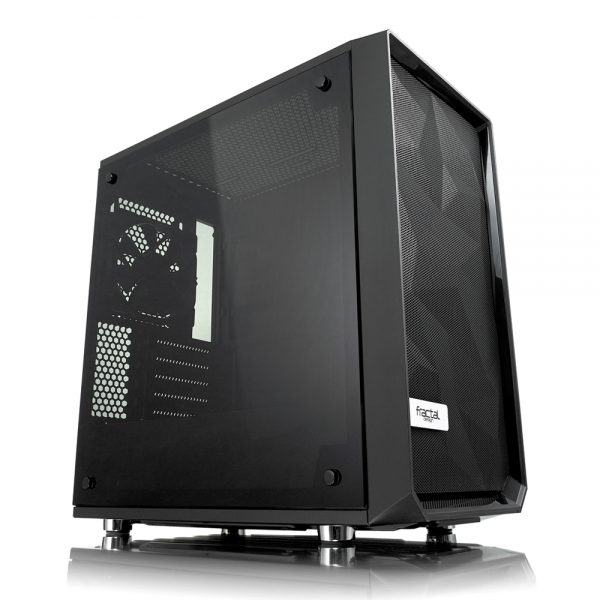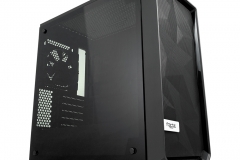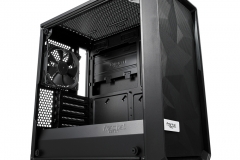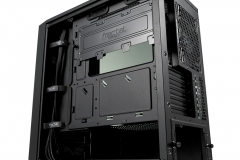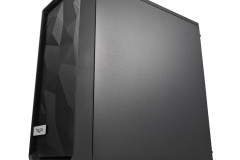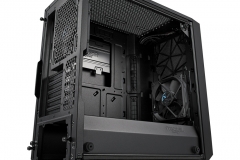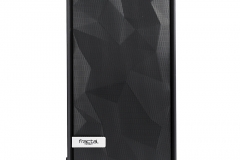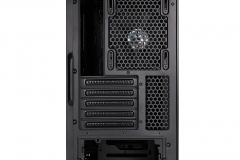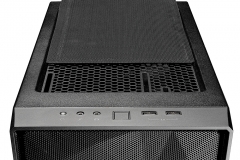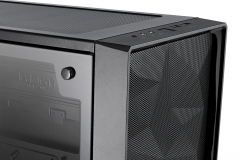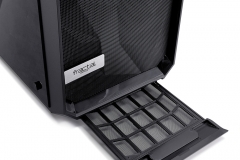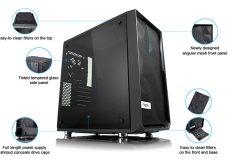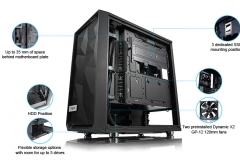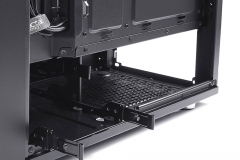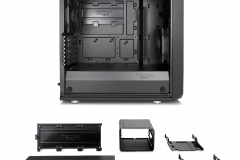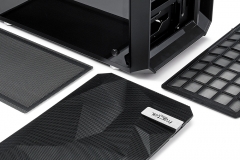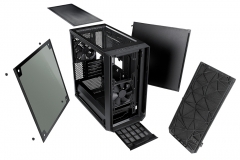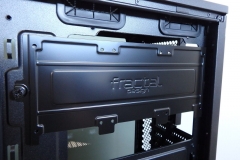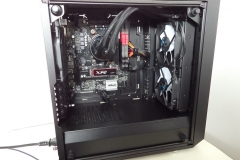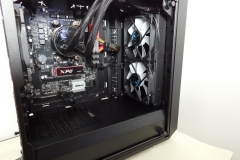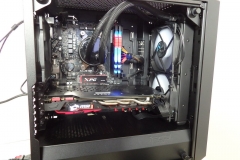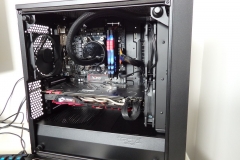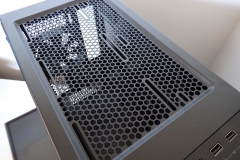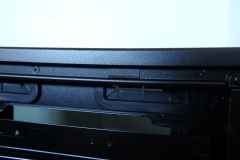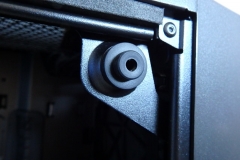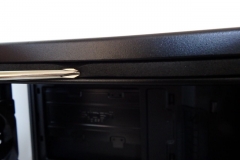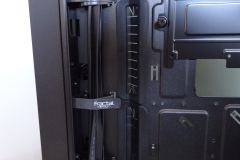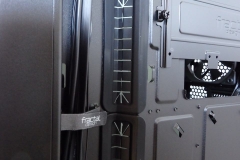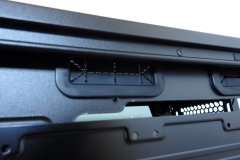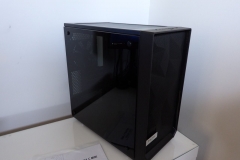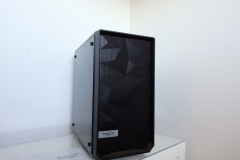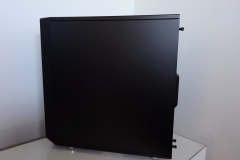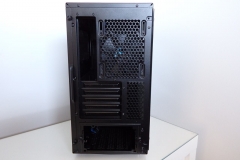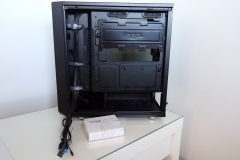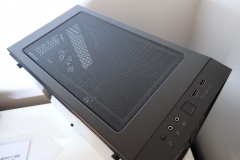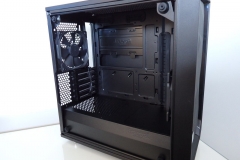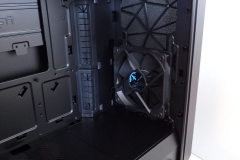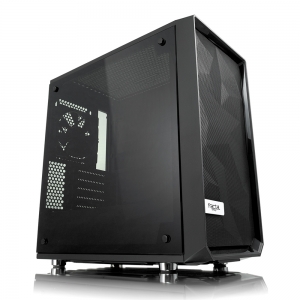Fractal Design just released their new Meshify C Mini – Dark TG to the Micro ATX sector and we were able to get hands on with it prior to launch. We also received an Edison 650W PSU and the Celsius S24 water cooler to include in our testing. The result was impressive.
The Meshify series is designed for high airflow and whilst it has a wide array of vents, the design allows for the system builder to decide exactly where the fresh air is drawn in and how the warm air is then exhausted from the rig. The undercurrent of ‘stealth’ is also prevalent in the front asymmetrical angular mesh panel, the heavily tinted tempered glass side panel and the cable management to hide the cables needed to make your PC actually work. What isn’t immediately obvious until you build in the Meshify C Mini is how effectively the cable and storage management system keeps the chamber relatively open; “Open” is good and what we really like to see when looking at cases. The smaller the case, the more open we want to see the motherboard chamber because an open chamber allows for unobstructed airflow across the heat sinks and a better supply of air for the components like the graphics card and CPU cooler.
I’ve tested and used most of the Fractal Design cases in the past and found the airflow potential of most of them to be good – the Meshify C takes this to the next level with optimal filtered airflow. The fan mounting points available mean that you can move air through the case in just about any way you like except sideways. Water cooling options are also high end in that the front of the case can handle up to a 280mm radiator.
Builders who are looking to run a healthy overclock on an MATX platform should be looking at this case. It performs similar to an open air test bench but still suppresses internal case noise from graphics cards and hard drives more than I expected. It isn’t as quiet as a Define series case from Fractal Design but the Meshify C mini lacks the sound proofing material and has more open grilles.
Core Feature Set
- Angular mesh front panel
- Tinted tempered glass side panel
- Subtle but distinctive aesthetic styling
- Configurable storage allowing for up to 5 drives (5×2.5″ or 3×2.5″ & 2×3.5″)
- Vibration-dampening rubber grommets on the hard drive trays
- Two Fractal Design Dynamic X2 GP-12 120 mm fans are included
- Open interior layout creates an unobstructed airflow path from front intake to rear exhaust
- Easy-to-clean filters on the front, top and base
- Full length power supply shroud conceals drive cage and excess cabling for unrestricted airflow and a clean looking interior
- Up to 35 mm of space behind motherboard plate with grommeted pass-throughs for cables
There are a lot of features and design considerations to like here but let’s look at the specifications to be thorough.
Specifications
| 3.5" or 2.5" Drive capacity | 2 |
| Dedicated 2.5" drive capacity | 3 |
| Expansion slots | 5 |
| Motherboard compatibility | mATX, ITX |
| Power supply type | ATX |
| Total fan mounts | 6 |
| Front fan | 2x 120 or 2x 140 1x Dynamic X2 GP-12 included |
| Top fan | 2x 120/140 |
| Rear fan | 1x 120 1x Dynamic X2 GP-12 included |
| Bottom fan | 1x 120 |
| Side fan | No |
| Dust filters | Bottom fan + PSU Front fans Top panel |
| Front radiator | 120/240mm 140/280mm (max width 144mm) |
| Top radiator | 120/240mm (max component height on motherboard 40 mm) |
| Rear radiator | 120mm (max width 125mm) |
| Power supply depth limit | Maximum 175mm recommended |
| Graphics card length limit | Max 315mm with front fan mounted |
| CPU cooler height limit | 172mm |
| Dimensions | Length 405mm Height 411mm Width 208mm (as measured by PCTR) |
| Cable routing | 15-35mm space |
| Cable routing grommets | Yes |
| Fixed Velcro straps | Yes |
| Captive thumbscrews | Both side panels SSD brackets |
| Left side panel | Tempered glass panel |
Package contents
- Meshify C Mini – Dark TG computer case
- User manual
- Accessory box
- Top filter
Additional information
- EAN: 7340172700111
- UPC: 843276100117
- Product code: FD-CA-MESH-C-MINI-TGD
Check out the Fractal Design product page here
There are a few points worth noting in the specification table. The graphics card length of 315mm is generous and will fit the longer Gigabyte Windforce 3x cards with the triple cooling fans. This is without sacrificing the front fan that will feed air to a large high performance card. Three 2.5″ SSD mounts are conveniently placed on a bracket behind the motherboard tray and when combined with the 2 x 3.5/2.5″ drive bays in the lower chamber there is plenty of room for expansion.
A high airflow case isn’t much good without a wide range of fan/radiator mounting options. The specs above boast an impressive set of options for different cooling configurations. Builders may need to get a little creative in terms of where to stash the internal reservoir but there are a couple of places that would work.
Stealthy Appearance
Aesthetically, the case looks more bold than what we have seen from Fractal Design in their other series of PC chassis. Aside from the front mesh of asymmetrical triangles at angles that resemble a stealth fighter, the case is in line with other Fractal Design products. That front panel draws attention and I like it a lot but it’s fair to say that the effect may not resonate with everyone. Resonate or not, the front mesh effect is still subtle and unlikely to be a deal breaker on its own.
The tempered glass side panel is very sleek and effective. The dark glass effectively hides the contents when the PC is switched off and allows any LEDs to shine through when the system is running. In some ways, it’s a shame to hide the main chamber of the case with the PSU/HDD bay cover that keeps the cables out of sight. Even a novice builder could easily get a neat result in this case with minimal effort.
Test System
- AMD Ryzen 3 2200G
- Fractal Design Celsius S24 water cooler (front mounted)
- 16GB GEIL EVO X DDR4 3200
- ASRock A320M-HDV MATX Motherboard
- MSI GTX 1070
- ADATA XPG SX9000 250GB M.2 SSD
- Fractal Design Edison 650W Semi Modular PSU
- Logitech G310 keyboard
- Func MS-3 R2 Mouse
- ViewSonic XG2401 24″ Gaming Monitor
Observations
Opt for a Modular PSU – there is a concealed section but it’s still tight and there are also 2 3.5″ bays there so the less unused cables in your build, the better. The Fractal Design Edison 650W PSU we used is semi-modular and perfectly matched for this case.
The top of the case has 240mm radiator mounts which is good but be mindful that the top radiator may foul tall RAM modules (depending on your board layout) if you use a standard radiator and 25mm thick fans. I’d recommend drawing air in through a radiator at the front instead as we did in our test build.
The included Dynamic X2 GP-12 case fans are very quiet and virtually silent in general use.
The little things
It’s often the little things or the ‘one percenters’ that take a case from being good to great. The Meshify C Mini had enough of these little conveniences to nudge the case into “Editor’s Choice” territory. I’ll go through these now.
Captive thumbscrews are fantastic and I wish all cases came with them. These unscrew enough to allow you to remove a panel but they don’t actually come out of the side panel itself which means that you can’t lose them or forget to use them when re-fitting the panel. It also means that you can’t get them muddled up with the PCIE slot cover screws from inside the case that usually have a slightly different thread.
Anti-vibration foam tape has been used on the side panels to prevent them from buzzing if you have older or fast hard drives that can cause resonance in the case. I wasn’t expecting it on the Meshify C Mini but was very pleased to see such a simple measure implemented.
Three dust filters that are easy to clean. Fractal Design kept this simple and used magnets for the top and a slider for the base filter. The front panel is a little more involved to remove but took me less than 20 seconds when I removed it in a timed run. One of the down sides of having a high airflow case is that you get more dust ingress. Filters like these have been highly effective on other Fractal Design cases we’ve had in the lab but you do have to remember to give them a clean every so often. Thankfully the filters have been implemented in a way that makes cleaning them quick and easy.
Zip tie anchors are all over the place, there are so many places to secure zip ties that cable management is easy. The included Velcro strips and cable channel also make keeping things neat very straightforward. There are also enough holes in the case internal panels to route cables via the concealed section behind the board so that they are less visible for a tidy finish.
The middle motherboard standoff has a raised notch instead of a mounting screw that helps to hold the board in place for installation.
Cables access holes all have rubber grommets – these stayed in place as I pushed the larger power cables through and I wasn’t gentle. You would have to be pretty rough to dislodge the grommets in the Meshify C Mini.
The foresight to have a removable panel in the PSU cover to allow for increased vertical positioning of the front radiator in an MATX case is impressive as it allows you to have a larger radiator with some room for vertical adjustment to ensure that your hoses and end-tank aren’t in the way of anything else.
Practical build
The semi-modular Edison 650W power supply proved to be very quiet and the cables permanently attached to the unit were all used. We only needed to attach one modular cable for SATA power to the SSD and hard drive. We didn’t encounter any issues with cable space or when fitting the components.
I mounted the Celsius S24 water cooler to the front of the case as it blocked the DDR4 slots of the board. I’d like to point out that we were using a Ryzen 3 2200G so the only DDR4 3200 RAM we had handy was the GEIL EVO with the extremely tall RGB LED capped heat spreaders. Fortunately, the Celsius fitted easily at the front and still had room to accommodate the MSI GTX 1070 Gaming graphics card.
The motherboard is the $69 ASRock A320M-HDV budget entry level motherboard that we are currently reviewing. Initial impressions are good and the layout is consistent with most motherboards of the MATX form factor so there were no red flags in terms of cable routing, CPU cut-out provision in the motherboard tray or standoff placement. Everything went together with ease and the build was quick to assemble.
Although we didn’t use any cable extensions, there was room behind the motherboard tray to accommodate them and I noted several places where I could have run LED strips if I’d had any on hand.
During the build process, it occurred to me that this would be a good case for a first time builder due to the open chamber, ease of cable routing and forgiving nature of the chambers in that an oversight is easy enough to go back and correct at any stage of the build without needing to uninstall other components.
Build Quality
The review unit we received survived transit despite the courier’s best efforts to test the packaging. The box had actually been pierced on the side – significantly. After opening the box and removing all of the foam and plastic film, I was relieved to see that the unit itself had arrived in pristine condition. Good to know if you are ordering one of these online.
The case itself looks exactly as per the promotional photos. We looked at the quality of the powder coat, the mesh, the tempered glass (both sides), the front IO ports, cables, grommets and thumb screws. After searching for a flaw to photograph we gave up and declared the review sample “top shelf” in the quality department which is in line with every other Fractal Design chassis we’ve received since 2012. It’s nice to see that they have been able to maintain the standard for so long.
Pricing
Australian street prices haven’t come out yet but the ATX version is currently available for $139 and we’d expect the Meshify C Mini to be a fraction cheaper – hopefully around the $129 mark.
Final Thoughts
The Meshify C Mini has features that will appeal to many buyers, from basic system builders to enthusiasts who want to make the most of the water cooling options. We expect the price to be highly competitive and provide similar value to the Meshify C chassis. This is the perfect base for a high-end rig as it has great airflow and a subtle design that can be dressed up with LEDs or kept stealthy for a less showy build. The ability to house 3 x 2.5″ SSDs and 2 x 3.5″ mechanical hard drives is good for an MATX form factor chassis where most motherboards won’t have more than 6 SATA ports anyway.
After completing a system build in the Meshify C Mini Dark TG, I can’t find any legitimate room for improvement. The fans are brilliant and I was surprised to see 2 included with the case. If the price lands around the $129 mark, this would be great value as the fans are decent quality and provide good airflow with very little noise.
If you’re going for something stealthy, the angular front panel, blackout palette and dark tinted tempered glass should meet the brief. Also, consider that the Meshify C Mini – Dark TG also has enough configuration flexibility to suit almost any MATX requirement.
I wouldn’t hesitate to use the Meshify C Mini – Dark TG for a mid-sized personal build and if I was planning on overclocking this would probably be my first choice right now.
| Fractal Design Meshify C Mini Dark TG | |
|
PROS |
|
|
CONS |
– none |
| Awards |

